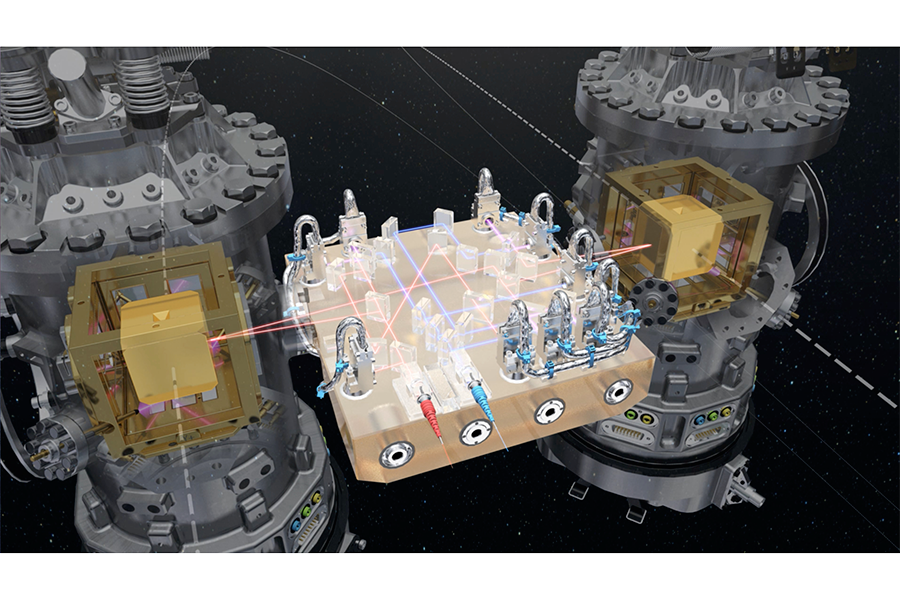How to hunt gravitational waves? Put a gigantic detector in space
Loading...
Before the dust has even settled on last week’s monumental announcement of the detection by Earth-based satellites of colliding black holes and the ripples of gravity they set off through spacetime, European scientists have announced that they are one step closer to launching similar detectors into space for the first time.
The European Space Agency (ESA) said Tuesday that the LISA Pathfinder had arrived at its destination 1.5 million kilometers (1 million miles) from the Earth and released a pair of cubes made from a mix of gold and platinum there. The idea is to keep the cubes still, undisturbed by cosmic forces such as thermal, magnetic, or electrostatic ones.
If scientists can keep these 2-kilogram (4.4 pound) cubes suspended in stillness, it will demonstrate the feasibility of one day placing similar ones into giant, gravitational wave detectors in space, says the agency. Such an instrument would be set up in an equilateral triangle, each side measuring 5 million kilometers (more than 3 million miles) long, and connected by laser.
“It would be the biggest constellation in the sky,” Paul McNamara, an ESA scientist who has been working on the LISA Pathfinder for two decades, told The Christian Science Monitor.
By contrast, the Advanced Laser Interferometer Gravitational-Wave Observatory, or LIGO detectors in Hanford, Wash., and Livingston, La., are 4-kilometer-long (2.5 miles) L-shaped tubes on the ground.
Both LIGO and LISA work in essentially the same way: laser light travels back and forth between mirrors, or cubes. When a gravitational wave passes through, it stymies the laser light by an exceptionally small amount – a tiny fraction of the diameter of a proton in the case of LIGO – but enough to set off the highly sensitive detectors, which are trained to drown out other noise.
But in the right spot in space, says Dr. McNamara, there is limited gravity and there are none of the seismic vibrations and other disturbances found on Earth, so European scientists hope that putting the laser interferometer detectors there will allow them to better feel the low-frequency waves of gravity rippling away from cataclysmic events billions of light years away, a phenomenon Albert Einstein first proposed a century ago in his general theory of relativity.
“This is why we sent the test cubes into space: to recreate conditions that are impossible to achieve in the gravitational field of our planet,” McNamara said in an announcement.
“Only under these conditions is it possible to test freefall in the purest achievable form. We can’t wait to start running experiments with this amazing gravity laboratory,” he said in an announcement.
After traveling for nearly two months aboard a rocket launched from Europe’s spaceport in Kourou, French Guiana on December 3, the cubes were dropped into orbit on Tuesday at a point between the Earth and Sun called a Lagrangian point, where all the gravitational forces in play between planets and other objects cancel each other out and allow the cubes to "hover," as the ESA explains. Technically, says McNamara, they’re moving, but only by about 20 nanometers, or a thousandth the width of a human hair.
Also helping the cubes hover is the fact that they’re made out of a perfect mix of the two dense metals (73 percent gold, 27 percent platinum) that leaves them nearly insusceptible to magnetic forces. The cubes also are ensconced in a small spacecraft that protects them from sunlight bouncing off, which could move them, and from other forces, such as bombardment by cosmic rays that can deposit in gold and platinum to create charge, says McNamara.
A device placed between the cubes shoots a laser between them to measure their positions constantly. And the casing enclosing them, and the laser device, ensures that they don’t drift. If they move slightly, six miniscule engines thrust them ever so gently back into place. McNamara explains that it would take 1,000 of these engines to lift a piece of paper off a desk.
The cubes will be in space for a year, undergoing a myriad tests. After that, it will take nearly 20 more years to get a gravitational wave detector into space.
“It’s a long endeavor, but well worth it,” says McNamara.






